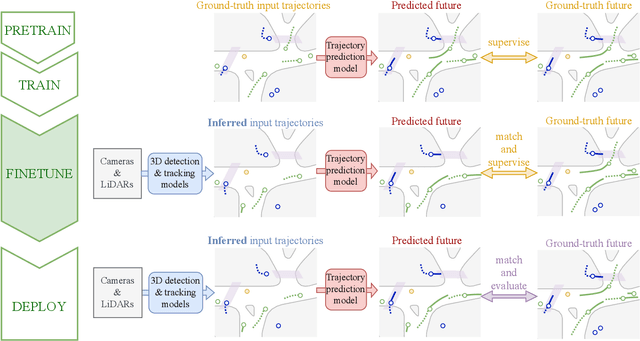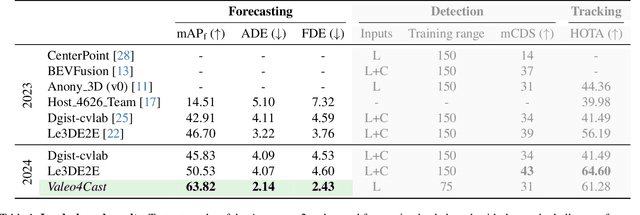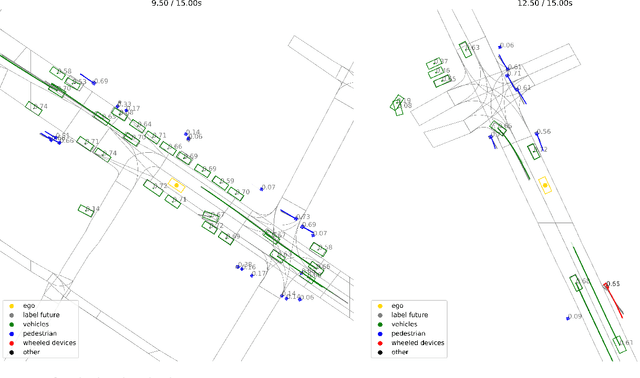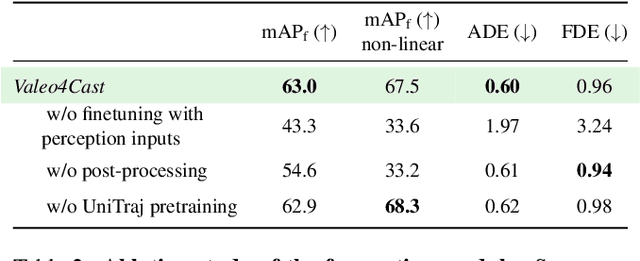Renaud Marlet
LOSC: LiDAR Open-voc Segmentation Consolidator
Jul 10, 2025Abstract:We study the use of image-based Vision-Language Models (VLMs) for open-vocabulary segmentation of lidar scans in driving settings. Classically, image semantics can be back-projected onto 3D point clouds. Yet, resulting point labels are noisy and sparse. We consolidate these labels to enforce both spatio-temporal consistency and robustness to image-level augmentations. We then train a 3D network based on these refined labels. This simple method, called LOSC, outperforms the SOTA of zero-shot open-vocabulary semantic and panoptic segmentation on both nuScenes and SemanticKITTI, with significant margins.
LiDPM: Rethinking Point Diffusion for Lidar Scene Completion
Apr 24, 2025Abstract:Training diffusion models that work directly on lidar points at the scale of outdoor scenes is challenging due to the difficulty of generating fine-grained details from white noise over a broad field of view. The latest works addressing scene completion with diffusion models tackle this problem by reformulating the original DDPM as a local diffusion process. It contrasts with the common practice of operating at the level of objects, where vanilla DDPMs are currently used. In this work, we close the gap between these two lines of work. We identify approximations in the local diffusion formulation, show that they are not required to operate at the scene level, and that a vanilla DDPM with a well-chosen starting point is enough for completion. Finally, we demonstrate that our method, LiDPM, leads to better results in scene completion on SemanticKITTI. The project page is https://astra-vision.github.io/LiDPM .
Clustering is back: Reaching state-of-the-art LiDAR instance segmentation without training
Mar 17, 2025Abstract:Panoptic segmentation of LiDAR point clouds is fundamental to outdoor scene understanding, with autonomous driving being a primary application. While state-of-the-art approaches typically rely on end-to-end deep learning architectures and extensive manual annotations of instances, the significant cost and time investment required for labeling large-scale point cloud datasets remains a major bottleneck in this field. In this work, we demonstrate that competitive panoptic segmentation can be achieved using only semantic labels, with instances predicted without any training or annotations. Our method achieves performance comparable to current state-of-the-art supervised methods on standard benchmarks including SemanticKITTI and nuScenes, and outperforms every publicly available method on SemanticKITTI as a drop-in instance head replacement, while running in real-time on a single-threaded CPU and requiring no instance labels. Our method is fully explainable, and requires no learning or parameter tuning. Code is available at https://github.com/valeoai/Alpine/
VaViM and VaVAM: Autonomous Driving through Video Generative Modeling
Feb 21, 2025Abstract:We explore the potential of large-scale generative video models for autonomous driving, introducing an open-source auto-regressive video model (VaViM) and its companion video-action model (VaVAM) to investigate how video pre-training transfers to real-world driving. VaViM is a simple auto-regressive video model that predicts frames using spatio-temporal token sequences. We show that it captures the semantics and dynamics of driving scenes. VaVAM, the video-action model, leverages the learned representations of VaViM to generate driving trajectories through imitation learning. Together, the models form a complete perception-to-action pipeline. We evaluate our models in open- and closed-loop driving scenarios, revealing that video-based pre-training holds promise for autonomous driving. Key insights include the semantic richness of the learned representations, the benefits of scaling for video synthesis, and the complex relationship between model size, data, and safety metrics in closed-loop evaluations. We release code and model weights at https://github.com/valeoai/VideoActionModel
LOGen: Toward Lidar Object Generation by Point Diffusion
Dec 10, 2024



Abstract:A common strategy to improve lidar segmentation results on rare semantic classes consists of pasting objects from one lidar scene into another. While this augments the quantity of instances seen at training time and varies their context, the instances fundamentally remain the same. In this work, we explore how to enhance instance diversity using a lidar object generator. We introduce a novel diffusion-based method to produce lidar point clouds of dataset objects, including reflectance, and with an extensive control of the generation via conditioning information. Our experiments on nuScenes show the quality of our object generations measured with new 3D metrics developed to suit lidar objects.
UNIT: Unsupervised Online Instance Segmentation through Time
Sep 12, 2024Abstract:Online object segmentation and tracking in Lidar point clouds enables autonomous agents to understand their surroundings and make safe decisions. Unfortunately, manual annotations for these tasks are prohibitively costly. We tackle this problem with the task of class-agnostic unsupervised online instance segmentation and tracking. To that end, we leverage an instance segmentation backbone and propose a new training recipe that enables the online tracking of objects. Our network is trained on pseudo-labels, eliminating the need for manual annotations. We conduct an evaluation using metrics adapted for temporal instance segmentation. Computing these metrics requires temporally-consistent instance labels. When unavailable, we construct these labels using the available 3D bounding boxes and semantic labels in the dataset. We compare our method against strong baselines and demonstrate its superiority across two different outdoor Lidar datasets.
Train Till You Drop: Towards Stable and Robust Source-free Unsupervised 3D Domain Adaptation
Sep 06, 2024Abstract:We tackle the challenging problem of source-free unsupervised domain adaptation (SFUDA) for 3D semantic segmentation. It amounts to performing domain adaptation on an unlabeled target domain without any access to source data; the available information is a model trained to achieve good performance on the source domain. A common issue with existing SFUDA approaches is that performance degrades after some training time, which is a by product of an under-constrained and ill-posed problem. We discuss two strategies to alleviate this issue. First, we propose a sensible way to regularize the learning problem. Second, we introduce a novel criterion based on agreement with a reference model. It is used (1) to stop the training when appropriate and (2) as validator to select hyperparameters without any knowledge on the target domain. Our contributions are easy to implement and readily amenable for all SFUDA methods, ensuring stable improvements over all baselines. We validate our findings on various 3D lidar settings, achieving state-of-the-art performance. The project repository (with code) is: github.com/valeoai/TTYD.
MILAN: Milli-Annotations for Lidar Semantic Segmentation
Jul 22, 2024



Abstract:Annotating lidar point clouds for autonomous driving is a notoriously expensive and time-consuming task. In this work, we show that the quality of recent self-supervised lidar scan representations allows a great reduction of the annotation cost. Our method has two main steps. First, we show that self-supervised representations allow a simple and direct selection of highly informative lidar scans to annotate: training a network on these selected scans leads to much better results than a random selection of scans and, more interestingly, to results on par with selections made by SOTA active learning methods. In a second step, we leverage the same self-supervised representations to cluster points in our selected scans. Asking the annotator to classify each cluster, with a single click per cluster, then permits us to close the gap with fully-annotated training sets, while only requiring one thousandth of the point labels.
A Study of Test-time Contrastive Concepts for Open-world, Open-vocabulary Semantic Segmentation
Jul 06, 2024



Abstract:Recent VLMs, pre-trained on large amounts of image-text pairs to align both modalities, have opened the way to open-vocabulary semantic segmentation. Given an arbitrary set of textual queries, image regions are assigned the closest query in feature space. However, the usual setup expects the user to list all possible visual concepts that may occur in the image, typically all classes of benchmark datasets, that act as negatives to each other. We consider here the more challenging scenario of segmenting a single concept, given a textual prompt and nothing else. To achieve good results, besides contrasting with the generic 'background' text, we study different ways to generate query-specific test-time contrastive textual concepts, which leverage either the distribution of text in the VLM's training set or crafted LLM prompts. We show the relevance of our approach using a new, specific metric.
Valeo4Cast: A Modular Approach to End-to-End Forecasting
Jun 12, 2024



Abstract:Motion forecasting is crucial in autonomous driving systems to anticipate the future trajectories of surrounding agents such as pedestrians, vehicles, and traffic signals. In end-to-end forecasting, the model must jointly detect from sensor data (cameras or LiDARs) the position and past trajectories of the different elements of the scene and predict their future location. We depart from the current trend of tackling this task via end-to-end training from perception to forecasting and we use a modular approach instead. Following a recent study, we individually build and train detection, tracking, and forecasting modules. We then only use consecutive finetuning steps to integrate the modules better and alleviate compounding errors. Our study reveals that this simple yet effective approach significantly improves performance on the end-to-end forecasting benchmark. Consequently, our solution ranks first in the Argoverse 2 end-to-end Forecasting Challenge held at CVPR 2024 Workshop on Autonomous Driving (WAD), with 63.82 mAPf. We surpass forecasting results by +17.1 points over last year's winner and by +13.3 points over this year's runner-up. This remarkable performance in forecasting can be explained by our modular paradigm, which integrates finetuning strategies and significantly outperforms the end-to-end-trained counterparts.
 Add to Chrome
Add to Chrome Add to Firefox
Add to Firefox Add to Edge
Add to Edge